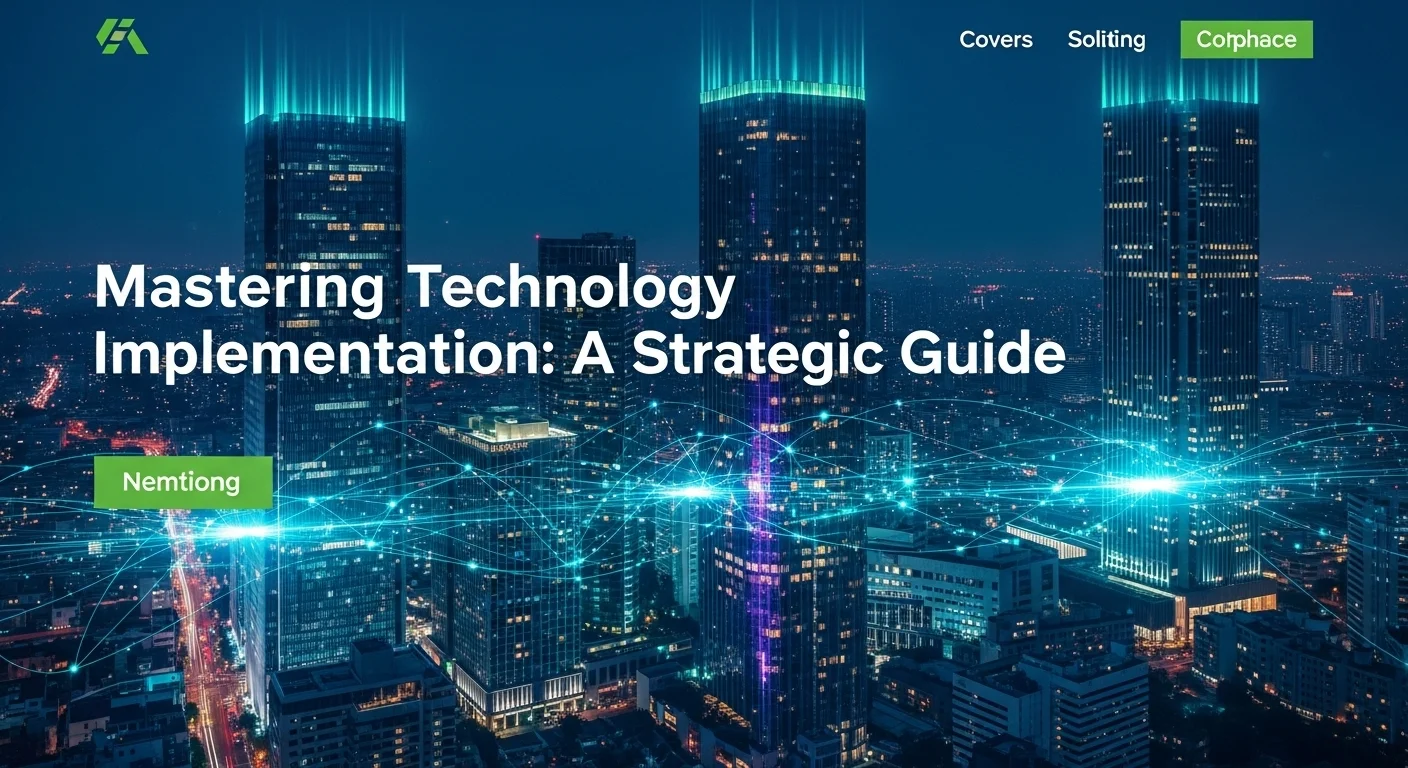Tech Implementation Done Right: A Real-World Guide to Cloud, AI, and MLOps

Executive Summary
In my years as a digital architect, I've seen one thing time and again: companies invest in incredible technology but fail to see the results. Why? Because the magic isn't in the tool itself, but in how you weave it into your business. Technology implementation isn't about flicking a switch; it's a strategic process that turns a tech investment into real-world value. This guide is my attempt to cut through the jargon and give you a straightforward playbook. We'll cover the essentials, from moving to the cloud to intelligently adopting artificial intelligence and scaling it effectively with MLOps. I'll share what I've learned works, what doesn't, and how you can navigate this complex process to give your business a genuine competitive edge.
Table of Contents
What is Technology Implementation, Really?
In the tech world, 'implementation' is a word we throw around a lot. But what does it actually mean? I've lost count of how many times I've seen a company spend a fortune on shiny new tech, only to watch it gather digital dust. True implementation isn't just installing software. It's a thoughtful, strategic process of integrating a new solution into the very heart of your operations and culture. It's the critical bridge between buying a tool and getting a return on that investment. Without a solid implementation plan, the most advanced technology on the planet can become a source of frustration and wasted money. It's about making technology work for your people, solving real problems, and pushing your business forward.
Why a Solid Plan is Your Biggest Advantage
In today's fast-moving market, the ability to effectively adopt new technology is what separates the leaders from the followers. Companies that get implementation right can adapt faster, work smarter, and deliver better experiences to their customers. This becomes incredibly clear when you're dealing with game-changing technologies like the cloud and AI.
Your First Step: Moving to the Cloud
For most businesses I work with, the digital transformation journey starts with the cloud. Moving your organization to the cloud is a massive leap from the old days of managing servers in-house. It promises flexibility, scale, and cost savings. But it's way more than just dragging files to a remote server. A successful public cloud setup, using services from giants like AWS, Google Cloud, or Microsoft Azure, requires deep thinking. You need to assess what your business truly needs, create a clear migration roadmap, and set up strong security and cost controls from day one. I've seen companies get hit with surprise bills or security gaps because they rushed this step. A careful plan will address which apps to move, the best way to move them, and how to get your team comfortable in this new environment.
The Next Level: Bringing AI Into Your Business
Artificial intelligence is set to change everything, but you can only tap into its power with a smart implementation. Bringing AI into your business isn't about deploying a fancy algorithm and hoping for the best. It starts with a clear business problem you want to solve. Many early AI projects fail not because the tech is bad, but because the strategy is weak. My advice is always to start with a specific, high-impact goal. Do you want to automate customer service, predict supply chain issues, or personalize your marketing? Define it and make sure you can measure it. And let's talk about data—it's the fuel for AI. A huge part of any AI project is the often-unglamorous work of collecting, cleaning, and organizing your data. You also have to manage the human side. Employees can be wary of AI, so clear communication and training are essential to show them that these tools are here to help them, not replace them.
Learning from Those Who've Done It Right
You don't have to reinvent the wheel. Look at the companies that are successfully using AI today. Retailers are personalizing shopping experiences to boost sales. Banks are using it to catch fraud in real-time. Hospitals are using AI to help doctors diagnose diseases faster. These success stories all have a few things in common: a clear goal, support from the top, a phased rollout starting with a small pilot project, and a commitment to continuous improvement. They prove that AI's true value comes from its thoughtful application to real-world challenges.
The Engine Room: Scaling AI with MLOps
Once you move from a few AI experiments to running hundreds of models in your daily operations, you hit a new wall: how do you manage it all? This is where MLOps (Machine Learning Operations) comes in. It’s about applying the same discipline to machine learning that we've used for years in software development (DevOps). MLOps creates a smooth, automated process for building, testing, deploying, and monitoring your AI models. Why does this matter? Because unlike normal software, an AI model's performance can degrade over time as it sees new data—we call this 'model drift.' Without MLOps, keeping these models updated is a slow, manual nightmare. By implementing a strong MLOps framework, you can deploy new models in days instead of months, ensure they're reliable, and truly scale your AI initiatives. It’s the foundation that helps a business become truly AI-driven.

A Complete Guide to Implementing Business Technology
So, you're convinced of the 'why.' Now, let's get into the 'how.' This isn't about abstract theory; think of this as a field guide from someone who's been in the trenches. A successful technology rollout is a planned journey, and this is your map. We'll break down the practical steps for moving to the cloud, bringing in AI, and scaling it all with a solid operational backbone.
Choosing the Right Implementation Approach
Before you write a single line of code, you need to pick your game plan. The two classic approaches are Waterfall and Agile.
- Waterfall: This is the traditional, step-by-step method. You define everything upfront, then move through sequential phases: design, build, test, deploy. It works well for projects where the requirements are crystal clear and unlikely to change. But in today's world, that's rare, and its rigidity can be a real handicap.
- Agile: This approach is all about flexibility and collaboration. You break the project into small, manageable chunks called 'sprints.' At the end of each sprint, you have something working to show for it. I'm a huge fan of Agile for complex projects like AI or cloud migrations because it lets you learn and adapt as you go.
In my experience, the best results often come from a hybrid approach, combining the solid planning of Waterfall with the iterative flexibility of Agile.
A Step-by-Step Guide to a Smooth Cloud Migration
Moving to the cloud is a cornerstone of modern business. Here’s how to do it without the usual headaches.
1. Assessment and Planning: Do Your Homework
This is where projects are won or lost. Start by taking a hard look at your current IT setup. Figure out which apps are good candidates for the cloud and which should be left behind. Most importantly, define your business goals. Are you trying to save money, become more agile, or improve your disaster recovery? Be specific. This is also when you'll choose your cloud provider (like AWS, Azure, or GCP) based on what you truly need.
2. Migration Strategy and Execution: Making the Move
With a plan in hand, it's time to execute. There are a few common ways to do this, often called the '6 R's':
- Rehosting (Lift and Shift): The quickest way. You move an application to the cloud with minimal changes.
- Replatforming: You make a few tweaks to the app to take better advantage of cloud features.
- Repurchasing: You ditch your old software and move to a cloud-based service (SaaS).
- Refactoring: The most intensive option. You completely re-architect the application to be 'cloud-native.' It's a lot of work but delivers the biggest long-term benefits.
- Retire: Get rid of applications you no longer need.
- Retain: Keep certain apps on-premise, usually for compliance or performance reasons.
My advice? Start with a small, non-critical pilot project. It's a great way to learn and build confidence before you tackle the big stuff.
3. Security and Governance: Lock It Down
In the cloud, security is a partnership. The provider secures the cloud, but you are responsible for securing what's in the cloud. Your implementation plan must include strong access controls, data encryption, and constant monitoring. Set up clear rules for how your team uses cloud resources and manages costs right from the start to avoid nasty surprises.
A Practical Framework for Implementing AI in Your Business
Bringing AI into your business successfully is about discipline and focus.
1. Start with a Problem, Not a Tool
I can't stress this enough. Don't start with 'we need an AI.' Start with 'we have a business problem.' Whether it's lowering costs, increasing sales, or reducing risk, identify a challenge where AI can make a real difference. Build a business case that clearly shows the expected return on investment.
2. Get Your Data in Order
An AI model is only as smart as the data it learns from. You need to assess the quality and availability of your data. This phase involves a lot of work—collecting, cleaning, and labeling data—but it's absolutely essential. You also need to be mindful of privacy regulations like GDPR right from the beginning.
3. Build and Test Your Model
This is where the data scientists work their magic, experimenting with algorithms to build a model that solves your problem. The key here is rigorous testing. You have to make sure the model works well on new, unseen data and isn't biased in its decision-making.
4. Pilot, Then Integrate
Before you go all-in, deploy your model in a limited, controlled pilot. This lets you see how it performs in the real world and get feedback from actual users. This is also where you'll tackle the technical challenge of integrating the model with your existing business software.
5. Full Rollout and People Management
Once your pilot proves successful, you can deploy at scale. But don't forget the people! You need a solid change management plan. Explain the benefits to your team, provide great training, and address their concerns. User adoption is what ultimately determines if your AI investment pays off.
A Technical Guide to Implementing MLOps
If you're serious about using AI across your company, MLOps is not optional. Think of it as the factory that produces and maintains your AI models.
1. Create a Unified Platform
You need to get your data scientists, engineers, and IT teams working together. An MLOps platform gives them a shared environment with tools for every stage of the process, like feature stores for managing data, model registries for tracking models, and experiment logs for comparing results.
2. Automate Everything: CI/CD/CT
The heart of MLOps is automation. Build automated pipelines for:
- Continuous Integration (CI): To automatically test new data and model code.
- Continuous Delivery (CD): To automatically deploy approved models into production.
- Continuous Training (CT): To automatically retrain models on new data to keep them accurate.
Tools like Jenkins, GitLab, or cloud-native services from AWS and Google are perfect for this.
3. Monitor, Monitor, Monitor
Once a model is live, you have to watch it like a hawk. Track not just its technical speed but its predictive accuracy. Set up alerts that tell you when a model's performance starts to slip, which can automatically trigger a retraining pipeline. This systematic approach turns machine learning from a one-off science project into a reliable, scalable business engine.

Expert Tips for a Smoother Technology Implementation
Embarking on a new technology project is exciting, but let's be honest, it can also be incredibly challenging. Over the years, I've seen projects soar and I've seen them crash and burn. The difference often comes down to a few key strategies that go beyond the technical manual. Here are my go-to tips and best practices to make sure your cloud and AI initiatives not only succeed but deliver real, lasting value.
Best Practices for Any Tech Project
No matter what you're implementing, these core principles are your foundation for success. Ignore them at your peril.
- Get Leadership Buy-In (It's Non-Negotiable): This isn't just an IT project; it's a business transformation. You need a champion in the executive suite who can secure funding, clear roadblocks, and keep the project aligned with the company's strategic goals. Trust me, without this, you're fighting an uphill battle.
- Focus on People (Change Management is Key): New tech changes how people work. You have to manage that change proactively. Communicate the 'why' behind the project early and often. Listen to your team's concerns and make them feel like they're part of the journey, not just having something forced on them.
- Design for Your Users: The best system in the world is useless if nobody wants to use it. Involve the people who will actually use the system every day in the design and testing process. A system built around their needs will always win.
- Define What Success Looks Like: Before you start, agree on how you'll measure success. Set clear, measurable goals (KPIs) tied to business outcomes. Are you trying to cut operational costs, increase sales leads, or deploy models faster? Track these metrics relentlessly to prove the project's value.
- Plan for Life After 'Go-Live': The project isn't over when you launch. Great implementation includes a plan for ongoing support, training, and improvement. Your business and the technology will evolve, and your system needs to evolve with them.
Advanced Strategies for Cloud and AI Implementation
Tips for a Smart Cloud Implementation
- Master Your Cloud Costs (FinOps): One of the biggest shocks for companies moving to the cloud is a runaway bill. Adopt FinOps practices from day one. This means creating a culture where your engineers understand the cost of their decisions. Use cloud cost management tools to monitor spending, set budgets, and optimize expenses.
- Automate Your Infrastructure (Infrastructure as Code): Manually setting up cloud environments is a recipe for disaster. It's slow and prone to errors. Use tools like Terraform or AWS CloudFormation to define your infrastructure in code. This makes your setups consistent, repeatable, and easy to rebuild.
- Design for Resilience: In the cloud, things can and do fail. Don't pretend they won't. Architect your applications to withstand failure by spreading them across different data centers. Use tools like load balancers and auto-scaling to handle outages gracefully and keep your service online.
Strategies for a Successful AI Implementation
- Start Small, Think Big: It's tempting to try and solve your biggest problem with AI right away. Don't. The most successful AI projects I've seen started with a small, manageable proof-of-concept. A quick win builds momentum, shows value, and teaches you invaluable lessons for bigger rollouts.
- Keep a Human in the Loop: For high-stakes decisions, full automation can be risky. Instead, use AI to assist a human expert. The AI can provide recommendations and analysis, but the person makes the final call. This builds trust and combines the best of machine intelligence and human judgment.
- Demand Explainable AI (XAI): In fields like finance or healthcare, a 'black box' AI that can't explain its reasoning is a non-starter. You need to know *how* your model reached a conclusion. Invest in XAI techniques to make your models transparent. This is critical for building trust, debugging problems, and ensuring fairness. For those who want to dive deeper, articles on AI strategy, like this one from Forbes, offer excellent perspectives.
Mastering the Final Mile: Implementing MLOps
Getting machine learning into production is where many AI dreams die. Here's how to make sure yours don't.
- Bridge the Culture Gap: MLOps lives at the intersection of data science and IT operations—two groups that often speak different languages. Create cross-functional teams with shared goals and a unified set of tools to get everyone on the same page.
- Standardize Your Workflow: To scale, you need a repeatable process. Create templates and reusable components for common tasks like data prep, training, and deployment. This saves time and ensures every model is built to the same high standard.
- Get Ahead of Model Drift: Don't wait for a model's performance to crash. Use automated monitoring to watch for changes in your data or the model's accuracy. Set up triggers that automatically retrain and deploy a new model when performance starts to slip, keeping your AI systems sharp and effective.
By combining these universal principles with tech-specific strategies, you can confidently navigate the complexities of any implementation. A successful rollout isn't just a technical win; it's a strategic capability that fuels innovation and gives you a lasting edge.
Expert Reviews & Testimonials
Sarah Johnson, Business Owner ⭐⭐⭐
The information about Implementation is correct but I think they could add more practical examples for business owners like us.
Mike Chen, IT Consultant ⭐⭐⭐⭐
Useful article about Implementation. It helped me better understand the topic, although some concepts could be explained more simply.
Emma Davis, Tech Expert ⭐⭐⭐⭐⭐
Excellent article! Very comprehensive on Implementation. It helped me a lot for my specialization and I understood everything perfectly.



